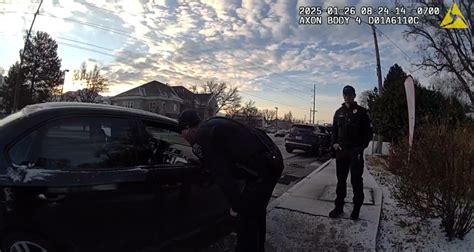
Cop’s Story Questioned: Video Contradicts Traffic Stop Account, Raising Questions About Police Transparency
A police officer in Oklahoma is under scrutiny after video footage surfaced that appears to contradict his account of a traffic stop, prompting an internal investigation and raising broader concerns about police transparency and accountability. The incident, which occurred in July, involved Officer Michael Swearingen of the Mannford Police Department and has ignited a debate about the veracity of police reports and the potential for discrepancies between official narratives and recorded evidence.
The Mannford Police Department has confirmed it is conducting an internal affairs investigation into the incident following the release of dashcam footage and body camera footage obtained through an Open Records Act request by local media outlets. The discrepancy between Officer Swearingen’s account and the video evidence has led to public calls for a thorough and impartial investigation.
The initial incident occurred on July 12th when Officer Swearingen initiated a traffic stop involving a vehicle driven by a civilian, identified as Steven Young. According to Swearingen’s official report, Young was pulled over for failing to maintain a lane and exhibiting signs of erratic driving, suggesting possible impairment. The report further detailed that Young was uncooperative and displayed aggressive behavior, leading to his arrest.
However, the video footage paints a significantly different picture. The dashcam video, which captures the entire encounter from the patrol car’s perspective, shows Young’s vehicle briefly crossing the center line before quickly correcting its course. The footage also shows Young complying with Officer Swearingen’s instructions during the stop. Furthermore, the body camera footage, offering a closer view of the interaction, does not appear to corroborate the officer’s claim that Young was exhibiting aggressive behavior.
“The video footage is raising serious questions about the accuracy of the officer’s report,” stated Mannford Police Chief Lucky Miller in an official statement released to the press. “We are committed to conducting a thorough and transparent investigation to determine the facts and ensure accountability.”
The conflicting accounts have spurred widespread criticism from local residents and civil rights advocates, who argue that the incident highlights the importance of body cameras and dashcams in ensuring police accountability. Many are also demanding that the Mannford Police Department implement stricter policies regarding the review of body camera footage and dashcam footage before approving police reports.
“This incident underscores the necessity of transparency and independent oversight in law enforcement,” said Brenda Starks, a local civil rights attorney. “Without the video evidence, the officer’s version of events would have remained unchallenged. This raises concerns about how many other incidents may have occurred where similar discrepancies exist but were not caught on camera.”
Adding fuel to the controversy is the fact that Young was initially charged with driving under the influence (DUI), resisting arrest, and failing to maintain a lane. These charges were subsequently dropped after Young’s attorney presented the video evidence to the district attorney. The dismissal of the charges has only intensified the public’s scrutiny of Officer Swearingen’s actions.
“The decision to drop the charges was made after a careful review of all available evidence, including the video footage,” confirmed a spokesperson for the district attorney’s office. “In light of the inconsistencies between the officer’s report and the video evidence, we determined that we could not proceed with the prosecution.”
The Mannford Police Department’s internal investigation will focus on several key areas, including a review of Officer Swearingen’s training records, his past performance evaluations, and any previous complaints filed against him. Investigators will also conduct interviews with Officer Swearingen, Steven Young, and any other witnesses to the incident.
Chief Miller has emphasized that the investigation will be conducted impartially and transparently. “We understand the public’s concerns and we are committed to ensuring that this matter is resolved fairly and justly,” Miller stated. “We hold our officers to the highest standards of conduct and we will not tolerate any actions that undermine the public’s trust.”
The incident also raises questions about the potential impact of implicit bias in policing. Some observers have suggested that Officer Swearingen’s perception of Young’s behavior may have been influenced by unconscious biases. While there is no direct evidence to support this claim, the incident has sparked a broader discussion about the need for law enforcement agencies to address issues of implicit bias through training and policy reforms.
Furthermore, the incident highlights the challenges faced by police departments in balancing the need for accountability with the protection of officers’ rights. Police unions often argue that officers are entitled to due process and that accusations of misconduct should be thoroughly investigated before any disciplinary action is taken. However, civil rights advocates contend that police departments have a responsibility to act swiftly and decisively when there is evidence of misconduct.
The outcome of the internal investigation could have significant implications for Officer Swearingen’s career. Depending on the findings, he could face disciplinary actions ranging from a written reprimand to suspension or termination. The results of the investigation could also be used as evidence in any potential civil lawsuits filed against the Mannford Police Department.
The case is also drawing attention to the importance of open records laws in ensuring government transparency. The release of the video footage was made possible through Oklahoma’s Open Records Act, which allows the public to access government documents and records. Without this law, the discrepancies in Officer Swearingen’s account may have remained hidden from public view.
“Open records laws are essential for holding government officials accountable,” said Sarah Johnson, executive director of the Oklahoma Open Government Foundation. “These laws empower citizens to scrutinize government actions and ensure that public officials are acting in the public’s best interest.”
The incident in Mannford is not an isolated case. Across the country, there have been numerous instances of police officers being accused of providing false or misleading accounts of events. These cases have often led to public protests and calls for police reform.
In recent years, there has been a growing movement to equip police officers with body cameras and to mandate the use of dashboard cameras in patrol cars. Proponents of these technologies argue that they provide an objective record of police interactions and can help to resolve disputes about what occurred during an encounter.
However, there are also concerns about the privacy implications of these technologies. Some civil liberties advocates argue that body cameras and dashcams can be used to track and monitor individuals, potentially infringing on their constitutional rights.
The debate over body cameras and dashcams is likely to continue as law enforcement agencies grapple with the challenges of balancing accountability with privacy. Ultimately, the success of these technologies will depend on how they are implemented and how the data they generate is managed.
The situation in Mannford underscores the complex challenges facing law enforcement agencies in the 21st century. As public expectations for transparency and accountability continue to rise, police departments must find ways to build trust with the communities they serve. This will require a commitment to ethical conduct, independent oversight, and a willingness to embrace new technologies that can help to ensure that justice is served.
The internal investigation into Officer Swearingen’s actions is ongoing, and the Mannford Police Department has pledged to release the findings to the public upon completion. The outcome of the investigation will be closely watched by both law enforcement professionals and civil rights advocates, as it could set a precedent for how similar cases are handled in the future.
As the investigation proceeds, the incident serves as a stark reminder of the importance of vigilance and the need for continuous efforts to promote transparency and accountability in law enforcement. The incident highlights the powerful role that technology, particularly video recording, can play in revealing potential discrepancies and ensuring that the pursuit of justice remains fair and impartial.







